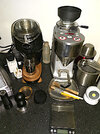Out of interest once dialled in, do you find you could just switch on and use the BE without more fiddling (pon the same bag of beans)
I've been using a Sage DB for a couple of years now. As I mentioned to just try a different bean on the BE I bought a 2nd grinder - the Sage SGP as getting the grind right on a bean can be painful especially the one I use most of the time.
So BE hopper full of these beans. Getting the dose right is "fun" as the grind time knob is rather course. However I overloaded the basket SLIGHTLY and noticed that this produced a slight impression of the shower screen fixing screw on a used puck. The bean needs a finer than usual grind. That seems to be needed for this to work. I'd keep and eye on the impression and if it showed signs of reducing make a miniscule adjustment to increase the grind time. So small an adjustment it wasn't easy to do but practice etc. This seems to be down to using a very oily bean. This allowed me to produce consistent shots. Just use the machine other than preheating it a bit as I mentioned before pulling the shot. I tasted 3 made on the trot and the first was rather different to the 2nd and the 3rd. When tuning I also used the pressure gauge. It has sectors, The last one just has dashes - over pressure. A very little way into that fine but too much and it went inconsistent.
2nd Sage grinder - always weighed beans in and check weighed to see if the dose was ok. Once settled it was pretty consistent, Some chips of beans settle on top of the burrs. and grinds get compacted in the grind chamber. Once that has happened output held to better than 1/2gm due to the chips that may or may not go in. There are always some there, The grinder just choked up if I used my oily beans. Dark roast monsoon malibar is extremely oily, I didn't try the other method used. Set 2 times on the grinder, check weigh and use the short time to adjust, Lot do this.
Maybe stick with your Mazzer. This is what I did with mine

Added a rubber camera lens hood as a puffer and weighed beans in. Added my own twist. I had a bit left over from turning aluminium that fitted and be dropped in on top of the beans. This prevented bean chips shooting all over the place without using a cover. My hands are big enough to create the puff by smartly squashing the lens hood. The weight helps stop the beans from pop corning so more like using as intended with a hopper full of beans providing the weight. So weigh in, fit the weight and run the grinder. Maybe 1 or 2 puffs. Then remove the weight, run a brush over the burrs. Put it back in, run and another puff. What went in comes out. The 2nd stage may add up to 1/2gm. I have a couple of small stick on buffer on the portafilter mount to ensure the heap of grinds in the portafilter is central. That really helps with consistency. Just use a 2 slope leveller and tamp.

The leveller helps keep the tamp square. No point in having an electronic version. If they have a grinder that doesn't have a funnel they find something similar and suitable and add it themselves. Some use a dremel on items like this
Find many great new & used options and get the best deals for Stainless Steel Octopus Ball Funnel Batter Dispenser for Family (L- 17mm hole) # at the best online prices at eBay! Free delivery for many products.
www.ebay.co.uk
Sage and an actual shot timer - apart from the DB not so sure. They all seem to be volumetric. Excess pressure dumps water into the drip tray.
Stepped grinder - the basic idea is trim up the shot with grinds weight, Too little and the puck will be soggy. Too much is a bit trickier. Maybe 1gm or grinds expansion when the get wet may result in 2 coarse a grind.

But what matters most is taste. Not some theoretical ideas about shot time and grinds wight to shot weight ratio. I do tend to stick to ~30sec but some do prefer 40. Ratio - I often find 2 to 3 is best generally around the middle.



